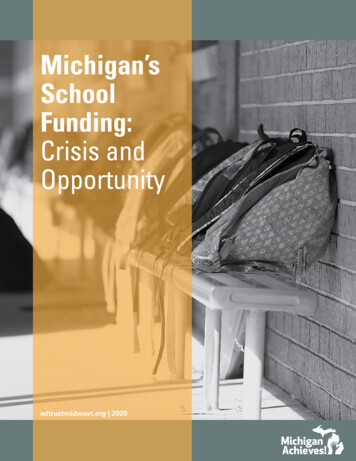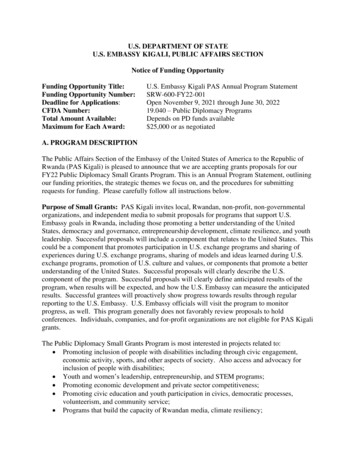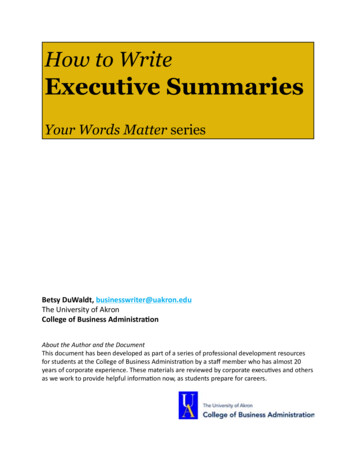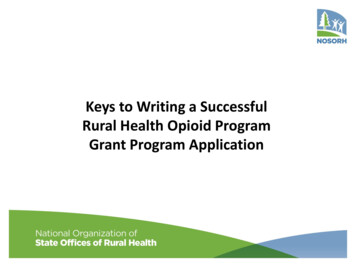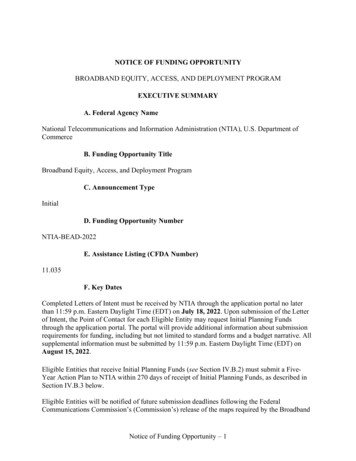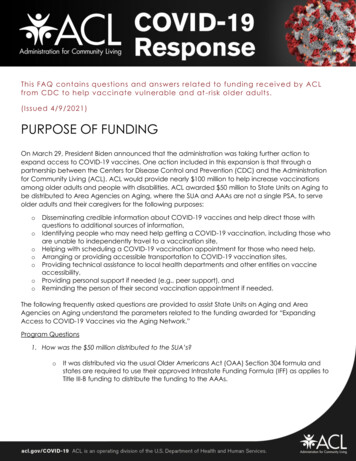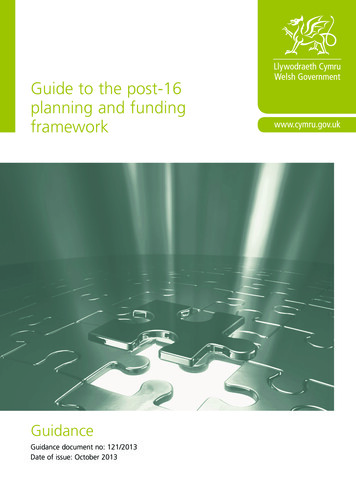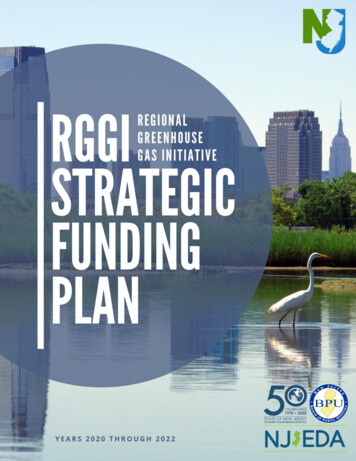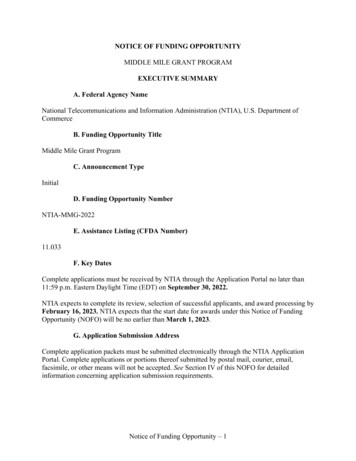
Transcription
NOTICE OF FUNDING OPPORTUNITYMIDDLE MILE GRANT PROGRAMEXECUTIVE SUMMARYA. Federal Agency NameNational Telecommunications and Information Administration (NTIA), U.S. Department ofCommerceB. Funding Opportunity TitleMiddle Mile Grant ProgramC. Announcement TypeInitialD. Funding Opportunity NumberNTIA-MMG-2022E. Assistance Listing (CFDA Number)11.033F. Key DatesComplete applications must be received by NTIA through the Application Portal no later than11:59 p.m. Eastern Daylight Time (EDT) on September 30, 2022.NTIA expects to complete its review, selection of successful applicants, and award processing byFebruary 16, 2023. NTIA expects that the start date for awards under this Notice of FundingOpportunity (NOFO) will be no earlier than March 1, 2023.G. Application Submission AddressComplete application packets must be submitted electronically through the NTIA ApplicationPortal. Complete applications or portions thereof submitted by postal mail, courier, email,facsimile, or other means will not be accepted. See Section IV of this NOFO for detailedinformation concerning application submission requirements.Notice of Funding Opportunity – 1
H. Funding Opportunity DescriptionThe Middle Mile Broadband Infrastructure Grant (MMG) Program provides funding for theconstruction, improvement, or acquisition of middle mile infrastructure. The purpose of the grantprogram is to expand and extend middle mile infrastructure to reduce the cost of connectingareas that are unserved or underserved to the internet backbone. See Section I of this NOFO forthe full Program Description.I. Funding InstrumentGrant.J. EligibilityTo apply for the MMG Program, an entity must be a State, political subdivision of a State, Tribalgovernment, technology company, electric utility, utility cooperative, public utility district,telecommunications company, telecommunications cooperative, nonprofit foundation, nonprofitcorporation, nonprofit institution, nonprofit association, regional planning council, Native entity,economic development authority, or any partnership of two (2) or more of these entities.K. Anticipated AmountsNTIA will make up to 980,000,000 available for federal assistance under the MMG Program( 1,000,000,000 minus two percent set aside to cover NTIA’s administrative costs). NTIAexpects to make awards under this program within the following funding range: 5,000,000 to 100,000,000. The period of performance for grants issued pursuant to this program ends fiveyears from the date on which the grant funds are made available to the eligible entity.L. Cost Sharing/MatchingThe amount of a middle mile grant awarded to an eligible entity through this program may notexceed 70 percent of the total project cost.1FULL ANNOUNCEMENT TEXTI.II.Table of ContentsProgram Description . 4A. Overview of the Middle Mile Grant Program . 4B. Definitions . 5Federal Award Information . 7A. Funding Availability . 7B. Period of Performance. 8C. Award Amount . 81Infrastructure Investment and Jobs Act of 2021, Division F, Title IV, § 60401(f), Public Law 117-58,135 Stat. 429 (November 15, 2021).Notice of Funding Opportunity – 2
D. Treatment of Unallocated Funds . 8E. Type of Funding Instrument . 8III. Eligibility Information and Program Details . 9A. Eligible Applicants. 9B. MMG Program Applicant Qualifications . 9C. Cost Sharing or Matching . 12D. Buildout Benchmarks . 13E. Prioritization of Applications Meeting Statutory Criteria . 13F. Connections to Anchor Institutions . 14G. Special Rules for Tribal Governments and Native Entities . 14H. Fair Labor Practices . 15I. Highly Skilled Workforce . 16J. Advancing Equitable Workforce Development and Job Quality Objectives . 17K. Climate Resilience . 19L. Civil Rights and Nondiscrimination Law Compliance . 21M. Other . 22IV. Application and Submission Information . 23A. Address to Request Application Package . 23B. Content and Form of Applications . 23C. Application Format . 26D. Requirements for Attachments Submitted through NTIA’s Grant Application System 27E. Certifications Regarding Debarment and Suspension . 28F. System for Award Management . 31G. Submission Dates and Times . 31H. Intergovernmental Review . 32I. Funding Restrictions . 32J. Material Representations and Public Disclosure of Applications . 34K. Other Submission Requirements . 34V. Application Review Information . 35A. Review Process for the MMG Program . 35B. Federal Awarding Agency Review of Risk Posed by Applicants . 41C. Anticipated Announcement and Award Dates . 42VI. Federal Award Administration Information. 42A. Federal Award Notices. 42B. Notification to Unsuccessful Applicants . 42C. Retention of Unsuccessful Applications . 42D. Administrative and National Policy Requirements . 42E. Reporting . 45F. Recipient Integrity and Performance Matters . 48G. Audit Requirements . 48H. Federal Funding Accountability and Transparency Act of 2006 . 49VII. Federal Awarding Agency Contact(s) . 49VIII. Other Information . 50A. Transparency . 50B. Protected and Proprietary Information . 50C. Funding Availability and Limitation of Liability . 51Notice of Funding Opportunity – 3
D. Third Party Beneficiaries . 51E. Waiver Authority . 51F. Paperwork Reduction Act . 51G. Transparency, Accountability, And Oversight Required . 52H. Unauthorized Use of Funds. 54I. Program DescriptionThe National Telecommunications and Information Administration (NTIA) issues this Notice ofFunding Opportunity (NOFO) to describe the requirements under which it will award grants forthe Middle Mile Grant (MMG) Program, authorized by the Infrastructure Investment and JobsAct of 2021, Division F, Title IV, Section 60401, Public Law 117-58, 135 Stat. 429 (November15, 2021) (Infrastructure Act or Act), also known as the Bipartisan Infrastructure Law. TheMMG Program provides funding for the construction, improvement, or acquisition of middlemile infrastructure.A. Overview of the Middle Mile Grant ProgramIn recent decades, access to the internet has played a critical and growing role in the ways inwhich Americans work, learn, receive health care, and participate in democracy. The COVID-19pandemic crystalized what many have known for a very long time: Broadband internet access isnot a luxury, but a necessity, for all Americans, regardless of their age, race, or income,irrespective of where they live, what languages they speak, what resources they have at theirdisposal, and what specific challenges they may face in their daily lives.Recognizing broadband’s fundamental role in today’s society and its centrality to our nation’scontinued health and prosperity, President Biden has pledged that every American must haveaccess to a reliable, affordable, high-speed broadband connection. Full participation in ourtwenty-first century economy requires no less. Yet affordable, reliable, high-speed internetaccess has remained elusive to many for too long, because they live in a location where noservice is available, the speed or quality of the service available is unreliable, or the offeringavailable is unaffordable. This digital divide is particularly acute for communities of color andlower-income areas and spans both urban and rural areas of the country.Passed on a bipartisan basis, the Infrastructure Act established the Middle Mile Grant Program tocomplement other programs focused on internet connectivity and digital equity. Middle mileinfrastructure does not reach the end user’s location, but typically aggregates large quantities oftraffic for carriage between networks. The variety of middle mile arrangements is broad. Middlemile infrastructure might carry traffic via undersea cable to remote locations such as Hawaii orAmerican territories and possessions elsewhere in the Pacific, may “backhaul” wireless trafficvia a fiber-optic link from an antenna mounted on a tower to the provider’s wired network, maybring the internet to previously unserved Tribal or Native lands, or may simply connectneighboring towns. Middle mile service, moreover, might be offered by a wide range of entities,from traditional retail Internet Service Providers, large technology companies that do not offerretail broadband at all, or electric utilities that increasingly recognize their capability to transformthe communications market. Regardless of who deploys and operates them, middle mileconnections are crucial to connectivity and competition.Notice of Funding Opportunity – 4
Recognizing the middle mile’s central importance, Congress appropriated 1 billion for theMMG Program and identified two key objectives: to “encourage the expansion and extension ofmiddle mile infrastructure to reduce the cost of connecting unserved and underserved areas to thebackbone of the internet” and to “promote broadband connection resiliency through the creationof alternative network connection paths that can be designed to prevent single points of failureon a broadband network.”2NTIA looks forward to receiving and reviewing a broad range of applications proposing creativeways to fill the gaps in our nation’s middle mile infrastructure and advance our national goals ofincreasing connectivity, affordability, and equity.B. Definitions(1) Anchor Institution.—The term “anchor institution” means a school, library, medical orhealthcare provider, community college or other institution of higher education, or othercommunity support organization or entity.(2) Assistant Secretary.—The term “Assistant Secretary” means the Assistant Secretary ofCommerce for Communications and Information or the individual who holds any successorposition.(3) Commission.—The term “Commission” means the Federal Communications Commission(FCC).(4) Eligible Entity.—The term “eligible entity” means— (A) a State, political subdivision of aState, Tribal government, technology company, electric utility, utility cooperative, public utilitydistrict, telecommunications company, telecommunications cooperative, nonprofit foundation,nonprofit corporation, nonprofit institution, nonprofit association, regional planning council,Native entity, or economic development authority; or (B) a partnership of two (2) or moreentities described in (A).(5) FCC Fixed Broadband Map.—The term “FCC fixed broadband map” means the map createdby the Commission under Section 802(c)(1)(B) of the Communications Act of 1934 (47 U.S.C. §642(c)(1)(B)).(6) Indian Tribe.—The term “Indian Tribe” means any Indian tribe, band, nation, or otherorganized group or community, including any Alaska Native village or regional or villagecorporation as defined in or established pursuant to the Alaska Native Claims Settlement Act (85Stat. 688) [43 U.S.C. § 1601 et seq.], which is recognized as eligible for the special programsand services provided by the United States to Indians because of their status as Indians.(7) Interconnect.—The term “interconnect” means the physical linking of two networks for themutual exchange of traffic on non-discriminatory terms and conditions.2Infrastructure Act § 60401(b)(1).Notice of Funding Opportunity – 5
(8) Internet Exchange Facility.—The term “internet exchange facility” means physicalinfrastructure through which internet service providers and content delivery networks exchangeinternet traffic between their networks.(9) Middle Mile Infrastructure.—The term “middle mile infrastructure”— (A) means anybroadband infrastructure that does not connect directly to an end-user location, including ananchor institution; and (B) includes— (i) leased dark fiber, interoffice transport, backhaul,carrier-neutral internet exchange facilities, carrier-neutral submarine cable landing stations,undersea cables, transport connectivity to data centers, special access transport, and other similarservices; and (ii) wired or private wireless broadband infrastructure, including microwavecapacity, radio tower access, and other services or infrastructure for a private wireless broadbandnetwork, such as towers, fiber, and microwave links.(10) Middle Mile Grant.—The term “middle mile grant” means a grant awarded under the MMGProgram.(11) Native Entity.—The term “Native entity” means— (A) an Indian Tribe; (B) an AlaskaNative Corporation; (C) a Native Hawaiian organization (as defined in Section 6207 of theElementary and Secondary Education Act of 1965 (20 U.S.C. § 7517)); (D) the Department ofHawaiian Home Lands; and (E) the Office of Hawaiian Affairs.(12) State.—The term “State” means any State of the United States, the District of Columbia andthe U.S. Territories and possessions.(13) Submarine Cable Landing Station.—The term “submarine cable landing station” means acable landing station, as that term is used in Section 1.767(a)(5) of Title 47, Code of FederalRegulations (or any successor regulation), that can be utilized to land a submarine cable by anentity that has obtained a license under the first Section of the Act entitled “An Act relating tothe landing and operation of submarine cables in the United States”, approved May 27, 1921 (47U.S.C. § 34) (commonly known as the “Cable Landing Licensing Act”).(14) Tribal Land.—The term “Tribal Land” means (A) any land located within the boundariesof— (i) an Indian reservation, pueblo, or rancheria; or (ii) a former reservation within Oklahoma;(B) any land not located within the boundaries of an Indian reservation, pueblo, or rancheria, thetitle to which is held— (i) in trust by the United States for the benefit of an Indian Tribe or anindividual Indian; (ii) by an Indian Tribe or an individual Indian, subject to restriction againstalienation under laws of the United States; or (iii) by a dependent Indian community; (C) anyland located within a region established pursuant to Section 7(a) of the Alaska Native ClaimsSettlement Act (43 U.S.C. § 8 1606(a)); (D) Hawaiian Home Lands, as defined in Section 801 ofthe Native American Housing Assistance and Self-Determination Act of 1996 (25 U.S.C. §4221); or (E) those areas or communities designated by the Assistant Secretary of Indian Affairsof the Department of the Interior that are near, adjacent, or contiguous to reservations wherefinancial assistance and social service programs are provided to Indians because of their status asIndians.Notice of Funding Opportunity – 6
(15) Tribal Government.—The term “Tribal government” means the recognized governing bodyof any Indian or Alaska Native tribe, band, nation, pueblo, village, community, component band,or component reservation, individually identified (including parenthetically) in the list publishedby the Secretary of the Interior most recently as of the date of enactment of the Act pursuant toSection 104 of the Federally Recognized Indian Tribe List Act of 1994 (25 U.S.C. § 5131).3(16) Trust Land.—The term “trust land” means any land that (A) is held in trust by the UnitedStates for Native Americans; (B) is subject to restrictions on alienation imposed by the UnitedStates on Indian lands (including native Hawaiian homelands); (C) is owned by a RegionalCorporation or Village Corporation, as such terms are defined in Section 3(g) and 3(j) of theAlaska Native Claims Settlement Act, respectively (43 U.S.C. § 1602(g), (j)); or (D) is on anyisland in the Pacific Ocean if such land is, by cultural tradition, communally-owned land, asdetermined by the Secretary of the Interior.(17) Underserved.—The term “underserved,” with respect to an area, means an area— (A) that isdesignated as a Tribally underserved area through the process set forth in Section III.G.2 of thisNOFO; or (B) that— (i) is of a standard size not larger than a census block, as established by theCommission; (ii) is not an unserved area; and (iii) as determined in accordance with the FCCfixed broadband map, does not have access to broadband service with— (I) except as provided in(II) — (aa) a download speed of not less than 100 megabits per second; and (bb) an upload speedof not less than 20 megabits per second; or (II) minimum download and upload speedsestablished as benchmarks by the Commission for purposes of the Act after the date ofenactment of the Act, if those minimum speeds are higher than the minimum speeds requiredunder (I).(18) Unserved.—The term “unserved,” with respect to an area, means an area— (A) that isdesignated as a Tribally underserved area through the process set forth in Section III.G.2 of thisNOFO; or (B) that— (i) is of a standard size not larger than a census block, as established by theCommission; and (ii) as determined in accordance with the FCC fixed broadband map, does nothave access to broadband service with— (I) except as provided in (II)— (aa) a download speedof not less than 25 megabits per second; and (bb) an upload speed of not less than 3 megabits persecond; or (II) minimum download and upload speeds established as benchmarks by theCommission for purposes of this Act after the date of enactment of this Act, if those minimumspeeds are higher than the minimum speeds required under (I).II. Federal Award InformationA. Funding AvailabilityNTIA will make up to 980,000,000 available for federal assistance under the MMG Program.3See Indian Entities Recognized by and Eligible to Receive Services from the United States Bureau ofIndian Affairs, at 86 Fed. Reg. 7554 (Jan. 29, 2021); see also Indian Entities Recognized and Eligible toReceive Services from the United States Bureau of Indian Affairs; Correction, 86 Fed. Reg. 18552 (Apr.9, 2021) (updated by the Secretary of the Interior).Notice of Funding Opportunity – 7
B. Period of PerformanceTo be eligible to obtain a middle mile grant, an eligible entity shall agree to complete thebuildout of the middle mile infrastructure described in the application by not later than five (5)years after the date on which amounts from the grant are made available to the eligible entity.1. ExtensionsAn eligible entity may submit a request for an extension, which must include the justification forsuch an extension and all relevant circumstances. At the request of an eligible entity, theAssistant Secretary may extend the buildout deadline by not more than one (1) year if the eligibleentity certifies that:(i) the eligible entity has a plan for use of the grant funds;(ii) the project to build out middle mile infrastructure is underway; or(iii) extenuating circumstances require an extension of time to allow completion of theproject to build out middle mile infrastructure.Requests for extensions will be granted at the sole discretion of the Assistant Secretary.If an extension is granted, the Assistant Secretary shall modify any milestones as necessaryunder the extension.2. Reversion of FundsUnless the Assistant Secretary has granted an eligible entity an extension of time to complete itsproject, NTIA will make any grant funds not expended by the eligible entity by the end of theperformance period set forth in the Infrastructure Act available to other eligible entities for thepurposes provided in the MMG Program.C. Award AmountNTIA expects to make awards under this program within the following funding range: 5,000,000 to 100,000,000. This range is not a required minimum or maximum, but eligibleentities requesting amounts for projects outside of this range must provide a reasonableexplanation for the variance.D. Treatment of Unallocated FundsIn the event that any funds remain available after grants have been awarded to eligible entitiesthat submitted approved applications during the initial round of funding for the MMG Program,the Assistant Secretary shall either direct that additional applications submitted in response tothis NOFO be subject to further review, issue a new Notice of Funding Opportunity to addressdisbursement of remaining funds, or both.E. Type of Funding InstrumentThe funding instrument for awards made pursuant to the NOFO will be a grant.Notice of Funding Opportunity – 8
III. Eligibility Information and Program DetailsA. Eligible ApplicantsAn applicant must be an eligible entity as defined in Section I.B of this NOFO.B. MMG Program Applicant QualificationsPrior to entering into any award agreement, the Assistant Secretary shall ensure, consistent withthe requirements below, that any prospective middle mile grant recipient:1. Is capable of carrying out the proposed project in a competent manner, including a planto attract, train, or retain an appropriately skilled and credentialed workforce; and2. Has the financial, managerial, technical, and operational capability to carry out theproposed project and operate the resulting middle mile broadband network.To allow the Assistant Secretary to ensure the eligible entity meets the requirements set forthabove, each eligible entity must take the steps set forth below in connection with any applicationfor a middle mile grant. Additional threshold, project-specific, eligibility criteria are detailed inSection V.A.1.1. Financial Capabilitya. CertificationsEach applicant must supply a certification from an officer-level employee (or individual ofcomparable rank) attesting that it is financially qualified to meet the obligations associated with aproject, that they will have available funds for all project costs that exceed the amount of thegrant, and that they will comply with all MMG Program requirements, including servicemilestones. To the extent the Grants Officer disburses funding only upon completion of theassociated tasks, each applicant must also certify that it has and will continue to have sufficientfinancial resources to cover its eligible costs for the project until such time as the Grants Officerauthorizes additional disbursements.b. Letter of CreditDuring the application process, each applicant must submit a letter from a bank meetingeligibility requirements consistent with those set forth in 47 C.F.R. § 54.804(c)(2) committing toissue an irrevocable standby letter of credit, in the required form, to the applicant. The letter shallat a minimum provide the dollar amount of credit offered and the issuing bank’s agreement tofollow the terms and conditions of NTIA’s model letter of credit. NTIA shall establish a modelletter of credit substantially similar to the model letter of credit established by the FederalCommunications Commission in connection with the Rural Digital Opportunity Fund (RDOF).44Rural Digital Opportunity Fund Order, 35 FCC Rcd at 773-77, Appx. C.Notice of Funding Opportunity – 9
NTIA will ensure, prior to issuing a middle mile grant award, that each eligible entity obtains anacceptable, irrevocable standby letter of credit in a value of no less than 25 percent of the awardamount.Each eligible entity shall provide with its letter of credit an opinion letter from its legal counselclearly stating, subject only to customary assumptions, limitations, and qualifications, that in aproceeding under Title 11 of the United States Code, 11 U.S.C. § 101 et seq. (the “BankruptcyCode”), the bankruptcy court would not treat the letter of credit or proceeds of the letter of creditas property of the winning bidder's bankruptcy estate under Section 541 of the Bankruptcy Code.An eligible entity may obtain a new letter of credit or renew its existing letter of credit to reduceits value in accordance with the following limitations: Upon demonstrating to the satisfaction of the Assistant Secretary that it has completedthe buildout of 40 percent of project miles, an eligible entity may obtain a new letter ofcredit or renew its existing letter of credit so that it is valued at no less than 20 percent ofthe award amount.Upon demonstrating to the satisfaction of the Assistant Secretary that it has completedthe buildout of 60 percent of project miles, an eligible entity may obtain a new letter ofcredit or renew its existing letter of credit so that it is valued at no less than 15 percent ofthe award amount.Upon demonstrating to the satisfaction of the Assistant Secretary that it has completedthe buildout of 80 percent of project miles, an eligible entity may obtain a new letter ofcredit or renew its existing letter of credit so that it is valued at no less than 10 percent ofthe award amount.c. Audited Financial StatementsEach applicant shall submit financial statements from the three prior fiscal years that are auditedby an independent certified public accountant. If the applicant is not audited in the ordinarycourse of business, in lieu of submitting audited financial statements it must submit unauditedfinancial statements from the three prior fiscal years and certify that it will provide financialstatements from the three prior fiscal years that are audited by an independent certified publicaccountant by an NTIA specified deadline. The Assistant Secretary will not approve any middlemile grant award unless the Assistant Secretary determines that the documents submitteddemonstrate the applicant’s financial capability with respect to the proposed project.Notice of Funding Opportunity – 10
2. Managerial CapabilityApplicants shall submit to the Assistant Secretary one-page resumes for (a) all key managementpersonnel and (b) all key personnel of subcontractors or other entities that will play substantialroles in building, managing, or operating the middle mile network built using MMG Programfunding. In addition, each applicant shall submit any necessary organizational chart(s) detailingall of its parent companies
Notice of Funding Opportunity - 2 H. Funding Opportunity Description The Middle Mile Broadband Infrastructure Grant (MMG) Program provides funding for the construction, improvement, or acquisition of middle mile infrastructure. The purpose of the grant program is to expand and extend middle mile infrastructure to reduce the cost of connecting
